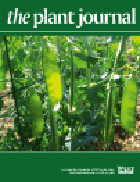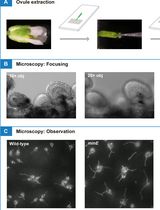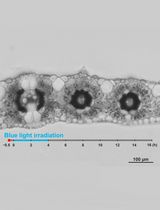- EN - English
- CN - 中文
Cytology and Microscopy: Immunolocalization of Covalently Modified Histone Marks on Barley Mitotic Chromosomes
细胞学和显微镜学:共价修饰组蛋白标记在大麦有丝分裂染色体上的免疫定位
发布: 2016年06月20日第6卷第12期 DOI: 10.21769/BioProtoc.1841 浏览次数: 9043
评审: Marisa RosaXinyan ZhangYurong Xie
Abstract
Barley is a diploid inbreeding crop with a genome of 5 GB organized into seven chromosomes. The relatively low chromosome number and their large size make barley an excellent model for chromosome cytogenetic studies of large genome cereal crops. Chromatin can be defined as euchromatin or heterochromatin. Euchromatin is gene-rich, less condensed, and transcriptionally active while the heterochromatin is gene-poor, remains highly condensed and has low transcriptional activity (Bartova et al., 2008; Sharakhov and Sharakhova, 2015). However, the mapping of nine Histone modifications has shown that this simple description is not accurate in barley. Instead, it has been shown that combinations of histones carrying different covalent modifications reveal 10 chromatin states partitioning barley chromosomes into three global environments (Baker et al., 2015). Briefly, in this protocol, barley roots (cv Morex) were collected, fixed in paraformaldehyde and squashed onto slides. Chromosome spreads were immunostained using antibodies against specific histone modifications, in particular H3K27me3, K3K27me1 and H3K9me2. We used confocal imaging to acquire stacked images and confirm the locations of these histone modifications on barley chromosomes.
Keywords: BarleyMaterials and Reagents
- SterilinTM 9 cm petri dish
(Thermo Fisher Scientific, catalog number: 1011RR )
- Whatman® 9 cm filter paper (Sigma-Aldrich, catalog number: Z240079 )
- Fine marker pen permanent (STABILO International GmbH)
- HB graphite pencil
- 15 ml centrifuge tube (any brand)
- Single edge razor blade (Thermo Fisher Scientific, catalog number: 11904325 )
- 1.5 ml microcentrifuge tubes
(VWR International, catalog number: 89000-028 )
- Microscope Polysine® slide (Thermo Fisher Scientific, Menzel Glaser, catalog number: 10143265 ) or Superfrost® plus micro slide (VWR International, catalog number: 48311-703 )
Note: Currently, it is “Thermo Fisher Scientific, Thermo ScientificTM, catalog number: 10143265 ”. - Borosilicate glass coverslip, 25 x 50, thickness 0.13 mm (VWR International, catalog number: 631-0137 )
- Tissue paper
- PAP pen for immunostaining (Sigma-Aldrich, catalog number: Z377821 )
- 0.45 μm, 26 mm diameter syringe filter (Cole-Parmer, catalog number: UY-02915-58 )
- Glass Coplin staining jar (any brand)
- Seeds from barley cv. Morex
- Immersion oil, ImmersolTM W 2010 (Carl Zeiss)
- Autoclaved distilled water (Barnstead® E-pure 4 modules cartridges)
- 5% bleach (Domestos)
- 70% ethanol
- Liquid nitrogen
- Bovine serum albumin (BSA) (Sigma-Aldrich, catalog number: A7030 )
- Antibodies
- Primary antibodies: anti-trimethyl-histone H3 (Lys27) antibody (H3K27me3) (Merck Millipore Corporation, catalog number: 07-449 ), anti-monomethyl-histone H3 (Lys27) antibody (K3K27me1) (Merck Millipore Corporation, catalog number: 07-448 ) and histone H3K9me2 antibody (pAb) (H3K9me2) (Active Motif, catalog number: 39375 )
Note: Currently, it is “EMD Millipore Corporation, catalog numbers: 07-449 and 07-448 ”. - Secondary antibodies: goat anti-Rabbit IgG (H+L), Alexa Fluor® 488 conjugate (Thermo Fisher Scientific, catalog number: A-11034 )
- Primary antibodies: anti-trimethyl-histone H3 (Lys27) antibody (H3K27me3) (Merck Millipore Corporation, catalog number: 07-449 ), anti-monomethyl-histone H3 (Lys27) antibody (K3K27me1) (Merck Millipore Corporation, catalog number: 07-448 ) and histone H3K9me2 antibody (pAb) (H3K9me2) (Active Motif, catalog number: 39375 )
- Hoechst 33342 (10 mg/ml) (Thermo Fisher Scientific, Molecular ProbesTM, catalog number: H3570 )
- Vectashield antifade mounting medium (Vector Laboratories, catalog number: H-1000 )
- Clear nail varnish (Technic)
- Sodium chloride (NaCl) (Sigma-Aldrich, catalog number: S7653 )
- Potassium chloride (KCl) (Sigma-Aldrich, catalog number: P9541 )
- Sodium phosphate dibasic (Na2HPO4) (Sigma-Aldrich, catalog number: 255793 )
- Potassium phosphate monobasic (KH2PO4) (Sigma-Aldrich, catalog number: P5379 )
- Tween® 20 (Sigma-Aldrich, catalog number: P9416 )
- TritonTM X-100 (Sigma-Aldrich, catalog number: T8787 )
- Sodium hydroxide (NaOH) (Sigma-Aldrich, catalog number: S8045 )
- Paraformaldehyde (Sigma-Aldrich, catalog number: P6148 )
- Cellulase Onozuka R10 (Duchefa Biochemie, catalog number: C8001 )
- Pectolyase Y23 (Dushefa Biochemie, catalog number: P8004 )
- 10x PBS (see Recipes)
- 1x PBS, 0.5% Triton® X-100 (see Recipes)
- 1 M NaOH (see Recipes)
- 4% formaldehyde (see Recipes)
- 0.1 M citric acid (see Recipes)
- 0.1 M sodium citrate (see Recipes)
- Citrate buffer (see Recipes)
- Enzyme mixture (see Recipes)
- Blocking solution (see Recipes)
Equipment
- Optoelectronically controlled small orbital shaker, 2,200 rpm, 230 V (IKA, model: VXR basic Vibrax® )
- Stereomicroscope (optional) (TEC Microscopes LTD., model: HM-4 )
- Light microscope (TEC Microscopes LTD., model: LM-2TR )
- Confocal microscope LSM 710 (Carl Zeiss)
- Objective (for Zeiss LSM 710): 60x APO C-apochromat 63x/1.20 W Korr M27
- DAPI fluorescence (blue 405, UV lamp) (Hoechst)
- Fitted 405 nm diode laser (for Hoechst acquisition on the LSM 710)
- Fitted 488 argon laser (for Alexa Fluor® 488 acquisition on the LSM 710)
- Moisture or wet chamber
Note: Commercially available for immunohistochemistry application or home made by using a plastic box lined with wet paper and wax sheet or glass rod to keep the slides out of direct contact with water (Figure 1). The chamber needs to be closed so the humidity is preserved during the protocol. - Aluminium slide tray, 20 slides capacity (Brunel Microscopes Ltd.)

Figure 1. Wet chamber. The principle of the wet chamber is to keep the sample moist at all times.
Software
- Zen 2010 software (Carl Zeiss, version 6.0)
- Fiji (Image J, version 1.49m) (Schindelin et al., 2012) with deconvolution package (EPFL, Biomedical Imaging Group, Switzerland)
- Imaris (optional) (Bitplane AG, version 8.1.2)
Procedure
文章信息
版权信息
© 2016 The Authors; exclusive licensee Bio-protocol LLC.
如何引用
Colas, I., Baker, K. and Flavell, A. J. (2016). Cytology and Microscopy: Immunolocalization of Covalently Modified Histone Marks on Barley Mitotic Chromosomes. Bio-protocol 6(12): e1841. DOI: 10.21769/BioProtoc.1841.
分类
植物科学 > 植物分子生物学 > 蛋白质
植物科学 > 植物细胞生物学 > 细胞成像
分子生物学 > 蛋白质 > 检测
您对这篇实验方法有问题吗?
在此处发布您的问题,我们将邀请本文作者来回答。同时,我们会将您的问题发布到Bio-protocol Exchange,以便寻求社区成员的帮助。
提问指南
+ 问题描述
写下详细的问题描述,包括所有有助于他人回答您问题的信息(例如实验过程、条件和相关图像等)。
Share
Bluesky
X
Copy link















